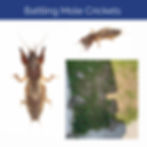Battling Mole Crickets: A Proactive Guide to Protecting Your Lawn
- Carlos Augusto
- Sep 20, 2023
- 2 min read
Updated: Nov 30

Mole crickets are insects that can cause damage to lawns and gardens by tunneling underground and feeding on plant roots. If you have a mole cricket problem, here are some steps you can take to address it:
Identification: Make sure you have correctly identified mole crickets as the source of the problem. Mole crickets are usually brown or gray, have large front legs for digging, and are about 1 to 1.5 inches long.
Monitor: Determine the extent of the infestation by monitoring your lawn or garden for signs of mole cricket damage, such as raised tunnels or dead grass patches. You may also hear their chirping noises at night.
Cultural Control:
Proper lawn maintenance: Maintain a healthy lawn by mowing it at the recommended height and watering it appropriately. A healthy lawn is more resistant to mole cricket damage.
Reduce moisture: Mole crickets are attracted to damp soil. Avoid overwatering your lawn, especially in the evening, as this can create favorable conditions for them.
Biological Control:
Introducing natural predators or nematodes that feed on mole crickets can help control their population. Beneficial nematodes like Steinernema and Heterorhabditis can be effective.
Chemical Control:
Insecticides: You can use insecticides specifically designed for mole cricket control. Follow the instructions on the product label carefully, and consider consulting a pest control professional for proper application.
Baiting: Mole cricket baits are available and can be effective. Apply them according to the manufacturer's instructions.
Trapping: You can set mole cricket traps in your garden to capture and remove them. These traps usually consist of containers buried in the ground with an attractant to lure the crickets.
Natural Barriers: Consider using physical barriers like mesh or netting to prevent mole crickets from tunneling into specific areas.
DIY Solutions: Some people have had success with DIY solutions like soapy water or a mixture of dish soap and water poured into mole cricket tunnels. However, these methods may not be as effective as other control measures.
Timing: It's important to apply control measures at the right time. Mole crickets are most active during their mating season, which varies by species and location. Applying control methods when they are actively tunneling and feeding is more effective.
Consult a Professional: If your mole cricket infestation is severe or persistent, it may be best to give Patriot Pest Management a call. We can assess the situation and recommend appropriate treatments.
Remember that mole cricket control may take time, and it's essential to be patient and persistent in your efforts to protect your lawn or garden from these pests. Additionally, always follow safety precautions when using pesticides or other chemical control methods.
